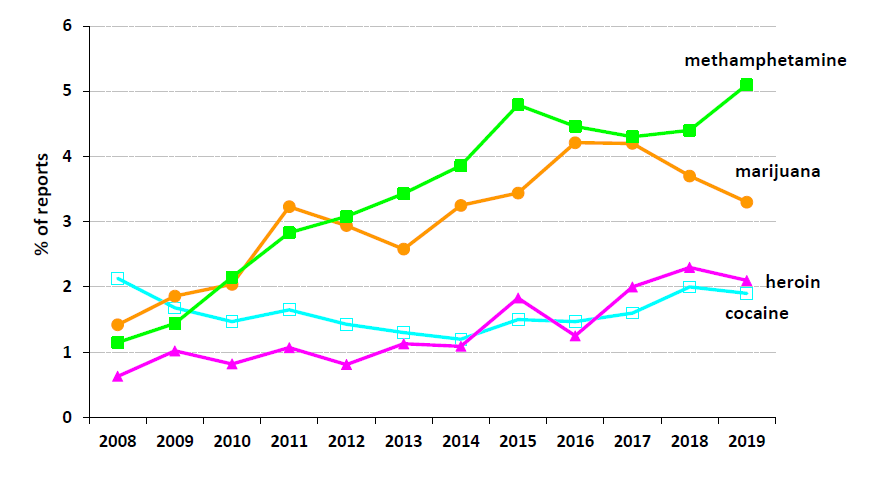Poison Control Calls
Methamphetamine, a stimulant, can increase alertness, attention, and energy through its effects on the reward system of the brain, and through its effects on the control of blood vessels, blood pressure and heart rate, blood sugar, and breathing.
Methamphetamine misuse, including overdose, can lead to serious psychological and physical health effects such as psychosis, confusion, panic states, paranoia, anger, aggression, restlessness, muscle pains, weakness, tremors, overactive reflexes, seizures, nausea, vomiting, diarrhea, a dangerously high body temperature, rapid breathing, irregular heartbeat, heart attacks, and heart failure (NIDA).
Those who experience potential methamphetamine or other poisoning should seek help by calling the 24/7 National Poison Control Hotline or by visiting their website at poison.org. Both options provide free, expert, and confidential guidance in a poison emergency. Calls will be routed to the local Poison Center, and managed by a Poison Specialist who is a registered nurse or pharmacist who will determine the severity of your case and provide recommendations.
(800) 222-1222 WEbPOISONCONTROLNationwide
Poison Control Center calls for meth is increasing in the US
Nationwide, from 2012-2021, there were a total 68,400 cases reported to all Poison Control Centers that mentioned methamphetamine exposure. Methamphetamine was the single exposure mentioned on the call for 32,979 (48.2%) of those cases, while the rest mentioned methamphetamine exposure along with exposure to at least one other substance.
From 2012-2021, the number of calls to the Poison Control Center mentioning methamphetamine exposure increased 137%, and calls mentioning methamphetamine as the single exposure increased 69% (Figures 1-2).
Los Angeles County
Meth accounts for the largest share of Poison Control calls for illicit substances
In Los Angeles County (LAC) from 2014-2019, there were a total of 25,311 reports for poison exposure calls to Poison Control Centers (Figure 3). Of the 3,878 Poison Control Systems reported for drugs in 2019, 14.5% were for illicit drugs.
Methamphetamine has been the most common illicit drug exposure that callers to the Poison Control Centers called about for help since 2012, followed by marijuana, heroin, and cocaine (Figure 4).
Figure
. Poison control system reports (calls) by illicit drug, LAC
Source: NDWS

References
Annual Report of the American Association of Poison control Centers' National Poison Data System (NPDS). Clinical Toxicology. 2012-2021. https://aapcc.org/annual-reports
National Drug Early Warning System (NDEWS). Los Angeles County Sentinel Community Site (SCS) Drug Use Patterns and Trends. 2015-2020.
National Institute on Drug Abuse (NIDA). 2019, May 16. Methamphetamine DrugFacts. Retrieved from https://nida.nih.gov/publications/drugfacts/methamphetamine on 2020, Jan 28